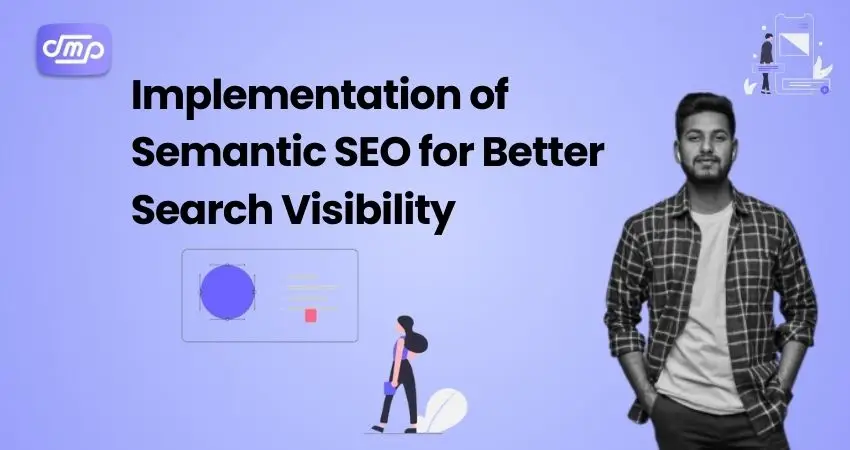
- July 20, 2024
- Digital Marketing, Google updates
- Search Engine Optimisation (SEO)
Table of Contents
By examining the context and meaning of search queries, semantic search engine optimization (SEO) is an advanced technique that goes beyond keyword matching. It strives to produce material that fully addresses users’ questions and is in line with their search intent. This method produces more precise and pertinent search results by assisting search engines like Google in deciphering the meaning of words and phrases.
Essential Ideas in Semantic SEO
- Search Intent: Figuring out the purpose of a user’s request. Is the customer wanting to buy anything, seeking knowledge, or seeking a specific solution?
- Contextual Relevance: Producing material that doesn’t just concentrate on keywords but also considers the topic and any related subtopics.
- Latent Semantic Indexing (LSI) Keywords: Including synonyms and similar terms that help search engines fully comprehend the topic.
- Entity Recognition: It is the process of identifying and utilizing entities—places, people, things, and concepts—in your writing. These entities are recognized by search engines, which use them to enhance text comprehension.
- Structured Data: Using schema markup to give search engines specific details about the material on your pages will improve how well they index and show up in search results.
- Material Depth and Breadth: Creating thorough, in-depth material that addresses every facet of a subject and gives readers useful information.
- User Experience: Making sure the information is understandable, interesting, and easily accessible in order to enhance the user experience.
Semantic SEO's advantages

- Higher Search Engine ranks: Semantic SEO raises search engine ranks by matching content to user intent and context.
- Enhanced Traffic: More people visit websites with high-quality, pertinent content, which also boosts organic traffic.
- Improved Engagement: Longer dwell times and lower bounce rates are the results of providing users with thorough and pertinent content.
- Enhanced Authority: Your website becomes an authority in your niche when it regularly produces worthwhile and pertinent material.
- User Intent: When implementing semantic search engine optimization, pay close attention to comprehending user intent and finding synonymous terms and phrases.
- Content Generation: Provide thorough writing that delves deeply into the subject while utilizing LSI keywords and entities.
- On-Page Optimization: To improve contextual relevance, make use of structured data, maximize meta tags, and make sure internal linking is done correctly.
- User Experience: Make sure your website loads quickly, make it mobile-responsive, and design with ease.
Optimizing for User Intent
Modern SEO tactics are fundamentally based on optimizing for user intent. It entails figuring out and responding to the unique requirements and driving forces behind a user’s search query. You may produce content that is more relevant, interesting, and likely to convert by concentrating on user intent.
Recognizing User Intentions
- Informational Intent: The user is searching for details or responses to particular queries. Frequently, these inquiries begin with “how to,” “what is,” “why,” “best ways,” and so on.
- Navigational Intent: Here the user wants to go to a particular website or page. These queries frequently contain specific brand names or website domain names.
- Transactional Intent: The user wants to buy something. or finish a deal. Words like “buy,” “order,” “purchase,” “discount,” etc. are frequently used in these requests.
- Commercial Investigation Intent: The user is conducting research in preparation for a potential purchase. These searches frequently include reviews, comparisons, and “best” or “top” lists.
How to Optimize for User Intent?
Perform Detailed Keyword Analysis
Determine the main terms and phrases that the people in your target audience use. To identify similar keywords and comprehend the volume and intent of those searches, use tools like Ahrefs, SEMrush, Google Keyword Planner, and others. Sort keywords according to the kind of intent that they convey to the user.
Examine the results of search engines (SERPs)
Look at the pages that rank highest for your desired keywords to get an idea of the kind of content that search engines are rewarding. Take note of the recurring components, including lists, photos, movies, and FAQs.
Enhance Page Elements
- Convey the User’s Purpose: Make sure your title tags and meta descriptions contain pertinent keywords and accurately convey the user’s purpose.
- Partitions and Subpartitions: Make use of the H1, H2, and H3 tags to organize your material logically and concisely.
- Format of Content: To make the content more readable and entertaining, use images, videos, numbered lists, bullet points, and infographics.
Improve the User Experience
- Page Speed: To stop users from bouncing around, make sure your pages load swiftly.
- Clear Navigation: Take advantage of straightforward navigation to assist customers in finding the information they need.
Make Use of Structured Data
Use schema markup to give search engines specific details about the material you write. You may use rich snippets, FAQs, reviews, and more to improve your listings.
Update and optimize content frequently
Keep an eye on the effectiveness of your material and change it as needed to stay current.Utilize tools such as Google Analytics to analyze user behavior in order to gain insight into how users engage with your material and make necessary improvements.
Advantages of Optimizing for User Intent
- Increased Engagement: Users are more likely to stay on a website longer and bounce less frequently when they find content that speaks to their intent.
- Increased Conversion Rates: Whether it’s through purchases, sign-ups, or other desired actions, you may increase conversion rates by catering to the individual needs of consumers.
- Better Search Rankings: Content that most closely fits user intent is given priority by search engines, which raises its ranks and increases its visibility.
- Enhanced User pleasure: Creating content that is both valuable and relevant enhances user pleasure in general and fosters brand trust.
Impact on Search Rankings and Traffic

Organic traffic and search rankings are greatly impacted by semantic SEO. Websites may increase user pleasure, visibility, and engagement by comprehending and putting semantic SEO principles into practice. Semantic SEO affects search ranks and traffic in the following ways:
- Contextual Relevance: Semantic SEO analysis is a tool that search engines employ to determine the context of content. Higher rankings can result from tailoring your content to the user’s search intent through the usage of synonyms, entities, and related terms.
- Entity Recognition: By recognizing and optimizing for entities (people, places, and things, for example), you help search engines better comprehend your content and raise the likelihood that it will appear in relevant search results.
- Content Caliber: Search engines prefer high-quality, in-depth material that addresses a topic completely. When visitors find your content interesting and valuable, you will see an increase in organic traffic and higher ranks.
- User Intent: Content that is in line with user intent gives users exactly what they want, which lowers bounce rates and lengthens dwell times—two factors that have a favorable impact on rankings.
- Rich Snippets: By using structured data, you may improve your search listings by adding rich snippets (pictures, star ratings, and FAQs), which will increase their visual appeal and likelihood of being clicked.
- Strong Meta Descriptions and Titles: Semantic SEO promotes the development of meaningful, compelling meta descriptions and titles that increase click-through rate (CTR) by emphasizing the importance of the content.
- Conversational Keywords: Using natural, conversational language is part of optimizing for voice search. This raises the possibility that users who rely on voice assistants will find your material through voice search results, increasing traffic.
- Featured Snippets: Answers from featured snippets are frequently pulled into voice search. Through content optimization for these snippets, you can secure a substantial portion of voice search traffic.
- Backlinks and Social Shares: Two crucial ranking components, backlinks, and social shares, are more likely to be earned by high-quality, semantically rich material.
- Optimizing for Core Web Vitals: Core Web Vitals (visual stability, interactivity, and loading speed) guarantees an improved user experience, which is an important ranking criterion.
- Local SEO: Local search visibility is increased by semantic SEO’s ability to comprehend local intent. Local entity and keyword optimization can lead to more local visitors to your website.
- Personalized material: By leveraging user behavior and preferences to present material in a more tailored manner, artificial intelligence and machine learning raise engagement and relevancy.
- Increased User Engagement: Visual material of the highest caliber can greatly increase user engagement, which in turn generates more traffic and higher rankings.
- Constant Optimization: The process of Semantic SEO is never-ending. Constantly improving and updating content to match user intent and search engine algorithms guarantees traffic and ranking development.
- Flexibility in Algorithm Modifications: By emphasizing the intent and content of users Semantic SEO tactics are more responsive to changes in search engine algorithms, meaning they consistently deliver results based on purpose and content quality.
Future Trends in Semantic SEO
Semantic SEO keeps improving as search engines get smarter and consumer expectations change. Recognizing and adjusting to new trends in this industry is essential to staying ahead of the curve. The following are some significant anticipated developments in semantic search engine optimization:
- Advanced Algorithms: To comprehend and handle search queries, search engines like Google are depending more and more on artificial intelligence (AI) and machine learning. The comprehension of the context and intent underlying inquiries is improved by algorithms such as MUM (Multitask Unified Model) and BERT (Bidirectional Encoder Representations from Transformers).
- Personalization: AI-powered personalization, which adapts content to each user’s unique tastes and actions, will proliferate.
- Conversational Queries: It’s becoming more and more important to optimize for natural, conversational language as the use of voice search develops. Content ought to discuss how Instead of typing, people speak.
- Answer boxes and featured snippets: Voice assistants frequently extract responses from featured snippets, therefore it’s critical to organize the material so that it addresses frequently asked questions succinctly and directly.
- Graphs: Search engines will keep growing their knowledge graphs by concentrating on comprehending entities and their connections. As a result, entity recognition-based search results will be more relevant.
- Structured Data: To improve search engines’ comprehension of the material and its context, structured data (schema markup) must be implemented and optimized.
- Page Experience: Search rankings will be influenced more and more by Google’s Core Web Vitals, which center on loading speed, interaction, and visual stability.
- Mobile-First Indexing: It will be crucial to optimize for mobile-first indexing because most searches are conducted on mobile devices. This includes a fluid mobile user experience, quick load speeds, and responsive design.
- Visual Search: Making photos and other visual content search-friendly is now necessary due to the emergence of technology such as Google Lens. This involves making use of image sitemaps, alt-text descriptions, and high-quality photos.
- Video Content: Video optimization for search engines will grow more crucial as long as video content remains the predominant format. This entails producing interesting, top-notch video material in addition to utilizing descriptive titles, tags, and transcripts.
- Intent Mapping: More effort will go into creating content strategies that correspond to particular user intents. This entails comprehending the many stages of the user journey and producing content that skillfully navigates each one.
- Contextual Relevance: It will be essential to improve the contextual relevance of content by topic modeling, content grouping, and improved internal linkage.
- Interactive Content: By incorporating augmented reality and virtual reality into content marketing and search, fresh chances to create rich and interactive experiences. Semantic SEO’s next frontier will be search engine optimization for such content.
- Increased User Engagement: AR and VR offer new avenues for delivering information and value to users, which can greatly increase user engagement.
- Improved Context Understanding: As NLP research continues, search engines will be able to better match relevant information with search queries by being able to comprehend the context of content with greater accuracy. Text, audio, and visual inputs can all be used in multilingual and multimodal search queries. This is made possible by improved natural language processing (NLP) skills.
Conclusion
Constantly monitor user behavior and search engine algorithms by updating material, analyzing performance indicators on a regular basis, and making adjustments. You can produce content that not only ranks highly but also offers real value to users by using a semantic SEO strategy, which will help you succeed and expand over time in the digital sphere.
You may develop a more comprehensive and successful SEO plan that raises your website’s search engine ranks and attracts better-quality visitors by putting semantic SEO tactics to use. Better user engagement, more conversions, and long-term online success are the outcomes of this.











